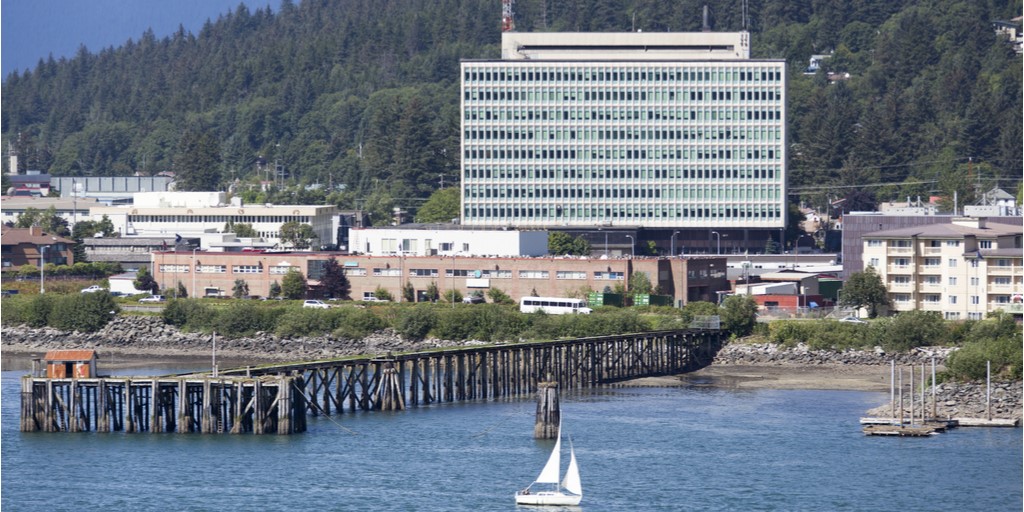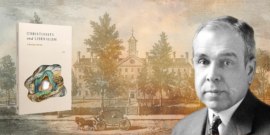Alaska is a magnificent state. Is its untamed, unspoiled splendor an asset or a defect?
Alaska: A Response to Pulliam
We appreciate the attention that Law and Liberty gave our state in Mark Pulliam’s Thursday post, “Alaska: America’s Last Frontier.” We commend Mr. Pulliam for visiting our state, talking to Alaskans, and reflecting on our situation. As he points out, Alaska is big, almost a fifth as large as the lower 48 contiguous states. Americans who live elsewhere often forget that Alaska is a state; that, unlike Hawaii, it is one of the continental, though not the contiguous, United States; and that it is the farthest west as well as the farthest north in the Union. He writes a useful primer for those who have never seen Alaska with their own eyes, pointing out features that might surprise many. We certainly hope that, should he succumb to his temptation to travel here again, he’ll look us up.
There is something true in the old argument of Frederick Jackson Turner that the frontier shaped the practice of American citizenship. Pulliam saw signs that sometimes it still does in Alaska. For example, our polar bears enjoy eating human garbage, and if you do not arm yourself properly, they might eat you. Hence our efforts to keep garbage out of the reach of bears. Just this summer, however, a grizzly bear attacked and killed a hiker near a well-known trailhead in the municipality of Anchorage, then attacked and almost killed a member of his search party. The persistence of some frontier conditions here reinforces Alaskans’ devotion to their right to keep and bear arms under the Second Amendment.
Pulliam is right to point out the limitations of our current system of internal transportation. Alaska’s state railroad was built with federal funds and is important for commerce, summer tourism, and year-round access to rural areas, but it is not connected to other North American railroads. Alaska’s state highway numbers go only from 1 to 12. Except for the unpaved Dalton Highway, stretching north from Fairbanks across the Arctic Circle toward Prudhoe Bay on the Arctic Ocean, roads that connect the state to Canadian and U.S. highways are only in the southeastern part of the state. Nor can residents of the major population centers in south-central Alaska drive to our capital city. Juneau, built on a mountainside next to an icefield, is accessible only by plane or ferry.
The Frontier Isn’t What’s Fundamental
Our colleague Stephen Haycox, the leading Alaska historian (see his 2002 book Alaska: An American Colony among others) would argue that Pulliam’s observations about Alaskan self-reliance fit the state’s relatively small contingent of non-Native rural residents better than they fit either the urban majority—concentrated on the rail belt in Anchorage, the fast-growing communities of the Matanuska-Susitna Valley to its north, and in Fairbanks—or those who live in the 150 or so remote Native villages.
Research by Scott Goldsmith of the University of Alaska Anchorage’s Institute of Social and Economic Research supports Haycox. Goldsmith has shown, in his study of the state’s economy, that fully one-third of Alaska’s economic base is federal spending for the military, Native services, land management, and basic infrastructure.
Nor do Anchorage residents experience such privations as Pulliam supposes. Winter, on an inlet warmed by the Japan Current, is milder here than in Vermont or Minnesota. Opportunities for shopping and entertainment are comparable to those of similar-sized cities in the lower 48 states. And prices, while higher than the U.S. average, are well below those in New York, San Francisco, or Washington, D.C.
In any case, we believe that mores and the first principles that shape them are far more important than structural causes like the frontier in determining the civic character of the people. That belief underwrites our mission as teachers on the outer fringes of the American empire, in Alaska’s flagship university. Wise administration of our public and private affairs depends upon the broadest diffusion of liberal arts education, which citizens need to understand the first principles of our government, the U.S. Constitution, and the duties of republican citizenship. Pulliam and the readers of Law and Liberty may agree with this view, and may lament, as we do, that it is not so universal as once it was.
Our people’s education in and devotion to constitutional government have declined. The effects have been hard on Alaska, to the detriment of the entire Union. Had Alaska never suffered these effects, our state would be more prosperous and populous today. It would probably be one of the strongest pillars of the American republic.
Pulliam is incorrect when he writes, “Because of its remote location and sprawling, largely inaccessible land area, Alaska is sparsely populated.” Despite the limits of its road system, Alaska is no more remote, sprawling, or inaccessible than the Old West was, given modern capabilities. Today we can fly from Anchorage to Seattle for a conference in three hours and back the next day, in time to teach class in the shadow of the Chugach Mountains. Contrast this modern mobility with the immobility of earlier Americans: In a poignant letter to his brother in Connecticut, a veteran of the Revolutionary War wrote that because of the difficulty of travel, he was obliged to bid the other farewell until they met again in heaven. He was writing from Ohio.
In 1790, the Northwest Territories had 265,000 square miles and an estimated population of fewer than 4,000 settlers. Despite communication and travel more like the era of the Pax Romana than our own times, the states carved out of that territory grew quickly and tremendously—so much so that, by the time of the Civil War, their sons provided the shock troops of William T. Sherman’s Army of the West, which secured victory for the Union. Adding together the populations of Ohio, Indiana, Illinois, Michigan, and Wisconsin at the time of the first census taken 50 years after each was admitted as a state, the aggregate population of these five states exceeds 10 million. Contrast that growth with Alaska’s at the time of the first census taken 50 years after statehood in 1959. With a land mass more than double that of the Old Northwest, Alaska’s population had grown only from 229,000 in 1960 to 713,000 in 2010.
Why this contrast? We attribute it to the fact that Ohio, Indiana, Illinois, Michigan, and Wisconsin entered the Union when limitations on the federal government, self-government by the states, and federalism were understood and respected. Only Alaska and Hawaii have been admitted to the Union since Arizona became a state in 1912, when ideas about American government were beginning to change. Those new ideas are reflected in Alaska’s situation today.
Stunted in Its Cradle by Big Government
Alaska is a state by law but a territory in fact. About 60 percent of the Alaskan land mass is directly controlled by the federal government, with more land subject to indirect control. That amounts to quite a lot of “Forts, Magazines, Arsenals, dock-Yards, and other needful Buildings,” the only purposes for federal control of land within state boundaries recognized in Article I, section 8, of the Constitution. In addition, we chafe under other forms of federal interference that older states have also encountered—but they encountered them decades after their societies had already developed on their own.
Compounding this political problem is the misfortune of petroleum’s discovery early in our state’s history. If scarcity is the mother of innovation and entrepreneurship, oil is its curse. We became dependent upon that precious single resource, which is primarily produced by companies headquartered in London and Houston, not in Alaska. To this day, the largest company founded and still domiciled in Alaska employs only a few thousand people. Yet Alaska boasts enormous untapped economic advantages in the global economy. Our immense lands are rich in resources.
We sit at the confluence of fiber lines connecting four continents. By plane we are a jump over the polar cap from Europe. By the bend of the globe, our largest city, Anchorage, sits close to the midway point on the route between Asia and the Americas. The melting of ice in the Arctic Ocean is opening new, shorter sea routes between ports all around the Atlantic Ocean and ports in the Pacific, especially in the Far East.
Alaska is beautiful, and there is no reason why our state cannot both remain so and become a powerhouse of the Union. We can apply lessons learned in the 200 years since the Industrial Revolution without bearing its scars. We can leverage millennia of accrued knowledge reposing in Alaska Natives to show the world how a people can thrive in the Arctic. With proper planning, combining that ancient knowledge with modern methods and technology, we could make a home for many millions in harmony with the environment.
Although Americans in the lower 48 sometimes forget us in the great white north, our state is “a Hercules in the cradle,” to borrow Alexander Hamilton’s phrase. But the enervating effect of our changed system of government has prolonged the adolescence of your Hercules and has deprived you of his full strength.



